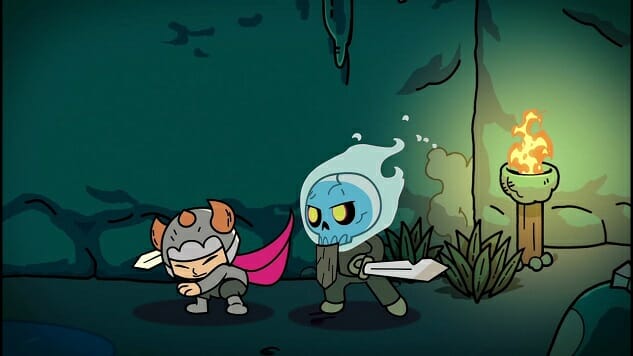When I started my first playthrough of The Swords of Ditto, my character was dark-skinned with bushy purple hair. I was shocked to see someone I would have made myself if given the opportunity. When I died, and my purple-haired hero was slain, I got a new hero, this time with a similar complexion but with straight, black hair. Despite its name, The Swords of Ditto isn’t all about repetition; the game regularly changes in all accounts, most interestingly with the character.
The Swords of Ditto follows a basic form modeled after games like The Legend of Zelda. The game is about a world plagued by an evil that can only be felled by those fated by the gods to wield the sword and rid the world of malice. Unlike the Zelda series, Ditto is a roguelike, meaning enemies, weapons and other utilities are randomly placed in new locations every time the hero dies.
Plenty of games, particularly in the roguelike genre, randomize characters to give each playthrough a new experience. But it’s not quite as common in traditional adventure or role-playing games. In cases like Zelda, the game provides the protagonist without any options for players to change their appearance. Others, like Mass Effect, give players options to customize their character how they see fit.
As a game that follows in the footsteps of The Legend of Zelda, randomly selecting a new hero feels exciting. Since its inception in the ‘80s, Zelda’s protagonist has always been Link, a fair-skinned blonde boy. Sometimes his eye color may change, his hair may be a bit of an ashier blonde, but every evolution of Link is still based off the same type of person. Many things around Link may change, from the time period to the environment. But Link’s basic appearance is never altered beyond the graphical distinction.
On one hand, having the main protagonist share defining features throughout each new iteration helps establish consistency. Even when the world changes, Link, in his green garb and Triforce of Courage, will always come to save the day. Yet the game tries to position Link as an extension of the player. His silence is used as a way for players to imagine how Link would react. Even his name can be changed by the player. Yet Link has only represented one type of hero, just as Zelda is only one type of princess and Ganon one villain. If the only defining features of the Hero of Time are certain green clothes and a Triforce on their hand, then anyone should be able to be that person. But for the Zelda series, that is not the case.
The Swords of Ditto rejects the idea that a hero looks like one type of person. The random generation of the hero provides a sense of ordinariness. Clearly the hero is someone who has the ability to wield the special sword, but there are no physical attributes that are explicitly or implicitly required. In classic Zelda fashion, a new character wakes up to the news that they have a big journey ahead of them. Sure, that character may sometimes have fair skin and blonde hair, but other times they are darker with bounds of curls on their head. The Swords of Ditto wants everyone to feel a sense of themselves as a champion, as someone capable of saving the world. I prefer this over character customization, because it leaves everything up to chance. Waking up one day to discover you’re the next hero should be sudden, so to have that person be of any color reflects the spontaneity and the thrill of one day having to get out of bed and save the world.
I’ve died a few times since starting my initial playthrough, but I still think often about my first champion who unfortunately died before she could bring down the evil Mormo. Even in failure, she brought the opportunity for another story to be told in the future, a chance for a new person—one who may look similar to her or who may not—to live out their story of adventure.
Shonté Daniels is a poet who occasionally writes about games. Her games writing has appeared in Kill Screen, Motherboard, Waypoint and elsewhere. Her poetry can be seen at Puerto del Sol, Baltimore Review, Phoebe, and others literary journals. Check out Shonte-Daniels.com for a full archive, or follow her for sporadic tweeting.
